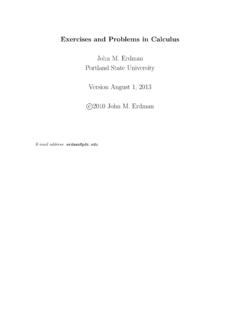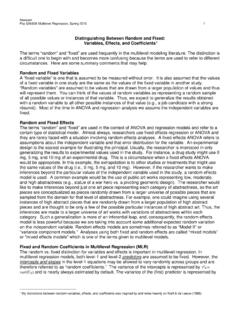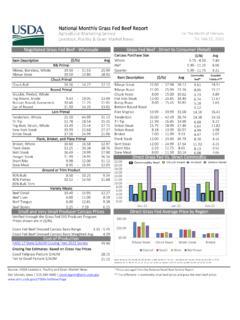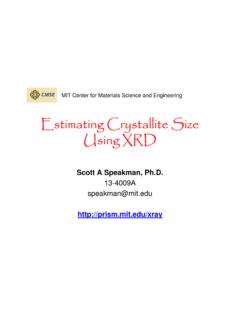Transcription of X-ray Diffraction (XRD) - Portland State University
1 X-ray Diffraction (XRD) What is X-ray Diffraction Basics of Crystallography Production of X-rays Applications of XRD Instrumental Sources of Error ConclusionsEnglish physicists Sir Bragg and his son Sir Bragg developed a relationship in 1913 to explain why the cleavage faces of crystals appear to reflect X-ray beams at certain angles of incidence (theta, ). The variable dis the distance between atomic layers in a crystal, and the variable lambda is the wavelengthof the incident X-ray beam; n is an integer. This observation is an example of X-ray wave interference(Roentgenstrahlinterferenzen ), commonly known as X-ray Diffraction (XRD), and was direct evidence for the periodic atomic structure of crystals postulated for several =2dsin Bragg s LawAlthough Bragg's law was used to explain the interference pattern of X-rays scattered by crystals, Diffraction has been developed to study the structure of all states of matter with any beam, ,ions, electrons, neutrons, and protons, with a wavelength similar to the distance between the atomic or molecular structures of =2dsin Bragg s LawThe Braggs were awarded the Nobel Prize in physics in 1915 for their work in determining crystal structures beginning with NaCl, ZnS and Bragg s Law.
2 N = 2dsin X-ray 1X-ray 2 Constructive interferenceoccurs only when n = AB + BC AB=BCn = 2 ABSin =AB/dAB=dsin n =2dsin = 2dhklsin hklAB+BC = multiples of n Constructive and Destructive Interference of WavesConstructive InterferenceIn PhaseDestructive InterferenceOut of What is X-ray Diffraction ? XRD? Measure the average spacings between layers or rows of atoms Determine the orientation of a single crystal or grain Find the crystal structure of an unknown material Measure the size , shape and internal stress of small crystalline regionsX-ray Diffraction (XRD)The atomic planes of a crystal cause an incident beam of X-rays to interfere with one another as they leave the crystal.
3 The phenomenon is called X-ray beamdiffracted beamfilmcrystalEffect of sample thickness on the absorption of X- of Diffracted X-raysby Photographic filmA sample of some hundreds of crystals ( a powdered sample) show that the diffracted beams form continuous cones. A circle of film is used to record the Diffraction pattern as shown. Each cone intersects the film giving Diffraction lines. The lines are seen as arcs on the -ScherrerCameraFilmX-rayfilmsample2 = 0 2 = 180 Point where incident beam entersBragg s Law and Diffraction :How waves reveal the atomic structure of crystalsn = 2dsin Atomicplaned=3 =3 =30on-integerX-ray1X-ray2l2 - Diffraction angleDiffraction occurs only when Bragg s Law is satisfied Condition for constructive interference (X-rays 1 & 2) from planes with spacing in Crystals-2 dimensionTo satisfy Bragg s Law, must change as , decreases as dincreases.
4 = 2dhklsin hklDifferent planes have different Basics of CrystallographyA crystal consists of a periodic arrangement of the unit cell into a lattice. The unit cell can contain a single atom or atoms in a fixed consist of planes of atoms that are spaced a distance dapart, but can be resolved into many atomic planes, each with a different ,band c(length) and , and angles between a,b and c are lattice constants or parameters which can be determined by crystalssmallest building blockUnit cellLattice(cm)( )CsCld1d2d3abc Seven Crystal Systems -ReviewMiller Indices: hkl -Review(010)Miller indices-the reciprocalsof thefractional interceptswhich the planemakes with crystallographic axesAxial length4 8 3 Intercept lengths1 4 3 Fractional intercepts 1 Miller indices4 2 1h k l4 8 3 8 01 00 1 0h k l4/ =0a b ca b cSeveral Atomic Planes and Their d-spacings in a Simple Cubic -Reviewa b c1 0 01 0 0 Cubica=b=c=a0a b c1 1 01 1 0a b c1 1 11 1 1a b c0 1 0 1 2d100d012(100)(110)(111)Black numbers-fractional intercepts, Blue numbers-Miller indices(012)Planes and Spacings -ReviewIndexing of Planes and Directions -Reviewabcabc(111)
5 [110]a direction: [uvw]<uvw>: a set of equivalentdirectionsa plane: (hkl){hkl}: a set of equi-valent Production of X-raysCross section of sealed-off filament X-ray tubetargetX-raystungsten filamentVacuumX-rays are produced whenever high-speed electrons collide with a metal target. A source of electrons hot W filament, a high accelerating voltagebetween the cathode (W) and the anode and a metal target, Cu, Al, Mo, Mg. The anode is a water-cooled block of Cu containing desired waterelectronsvacuummetal focusing capberyllium windowto transformerCharacteristic X-ray LinesSpectrum of Mo at 35kVK 1K K ( )< K 2K and K 2 will causeextra peaks in XRD pattern, and shape changes, but can be eliminated by adding the mass absorption coefficient of PreparationDouble sided tapeGlass slidePowders: m< particle size <40 mPeak broadeningless Diffraction occurringBulks.
6 Smooth surface after polishing, specimens should be thermal annealed to eliminate any surface deformation induced during number strongest lines line formula and name on Diffraction method used data and other data on specimen on Diffraction pattern. Quality of dataJoint Committee on Powder Diffraction Standards, JCPDS (1969)Replaced by International Centre for Diffraction Data, ICDF (1978)A Modern Automated X-ray DiffractometerX-ray TubeDetectorSample stageCost: $560K to 2 Basic Features of Typical XRD ExperimentX-ray tube1) Production2) Diffraction3) Detection4) InterpretationDetection of DiffractedX-rays by a DiffractometerPhoton counterDetectorAmplifierCCircle of DiffractometerRecordingFocalization CircleBragg -Brentano Focus Geometry, CullityPeak Positiond-spacings and lattice parameters = 2dhklsin hklFix (Cu k ) = dhkl= /2sin hkl For a simple cubic (a = b = c = a0)a0 =dhkl/(h2+k2+l2) , for NaCl, 2 220=46o, 220=23o, d220 = , a0= (Most accurate d-spacings are those calculated from high-angle peaks)2220lkhadhkl++=Bragg s Law and Diffraction .
7 How waves reveal the atomic structure of crystalsn = 2dsin Atomicplaned=3 =3 =30on-integerX-ray1X-ray2l2 - Diffraction angleDiffraction occurs only when Bragg s Law is satisfied Condition for constructive interference (X-rays 1 & 2) from planes with spacing =dhkl/(h2+k2+l2) , for NaCl, 2 220=46o, 220=23o, d220 = , a0= XRD Pattern of NaCl PowderIDiffraction angle 2 (degrees)(Cu K )Miller indices: The peak is due to X-ray Diffraction from the {220} of Peak Shape in intensityPeak Width-Full Width at Half MaximumFWHMI mportant for: Particle orgrain angle 2 IntensityBackgroundPeak position 2 Imax2maxImaxImodeCan also be fit with Gaussian, Lerentzian, Gaussian-Lerentzianetc.
8 No StrainUniform Strain(d1-do)/doNon-uniform Straind1 constantPeak moves, no shape changesPeak broadensEffect of Lattice Strain on Diffraction Peak Position and WidthDiffractionLinedod1 Shifts to lower anglesExceeds d0on top, smaller than d0 on the bottomRMS Applications of XRD XRD is a nondestructive technique To identify crystalline phases and orientation To determine structural properties:Lattice parameters (10-4 ), strain, grain size , expitaxy, phase composition, preferred orientation (Laue) order-disorder transformation, thermal expansion To measure thickness of thin films and multi-layers* To determine atomic arrangement Detection limits: ~3% in a two phase mixture; can be ~ with synchrotron radiationSpatial resolution: normally nonePhase IdentificationOne of the most important uses of XRD!
9 !! Obtain XRD pattern Measure d-spacings Obtain integrated intensities Compare data with known standards in the JCPDS file, which are for random orientations (there are more than 50,000 JCPDS cards of inorganic materials). Diffraction files: The task of building up a collection of known patterns was initiated by Hanawalt, Rinn, and Fevel at the Dow Chemical Company (1930 s). They obtained and classified Diffraction dataon some 1000 substances. After this point several societies like ASTM (1941-1969) and the JCPS began to take part (1969-1978). In 1978 it was renamed the Int. Center for Diffraction Data (ICDD) with 300 scientists worldwide. In 1995 the powder Diffraction file (PDF) contained nearly 62,000 different Diffraction patterns with 200 new being added each year.
10 Elements, alloys, inorganic compounds, minerals, organic compounds, organo-metallic compounds. Hanawalt: Hanawalt decided that since more than one substance can have the same or nearly the same d value, each substance should be characterized by it s three strongest lines (d1, d2, d3). The values of d1-d3 are usually sufficient to characterize the pattern of an unknown and enable the corresponding pattern in the file to be located. a b c2 a=b=c, (a) a=b c (a and c) a b c (a, b and c) Number of reflections Peak position Peak splittingPhase Identification-Effect of Symmetryon XRD PatternMore Applications of XRDD iffraction patterns of threeSuperconducting thin filmsannealed for different (2122) (2122)+ Tl2Ca2Ba2Cu3Oy (2223)b = a + (2223)CuO was detected bycomparison to standardsa b c (004)(004)IntensityXRD Studies Temperature Electric Field Pressure DeformationEffect of Coherent Domain size (331) Peak of cold-rolled andAnnealed 70Cu-30Zn (brass)2 K 1K 2As rolled200oC250oC300oC450oCAs rolled300oC450oCIncreasing grain size (t)








